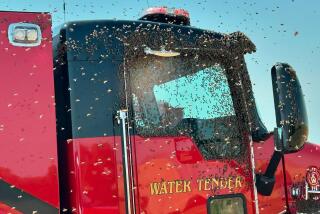State of Beeing
Beekeeping is so infectious it can quickly move from a simple hobby to a commercial venture.
Just ask Jaci Siehl of Silverado.
âWe used to go for hikes and see the feral hives in the trees,â Siehl said. â[My husband] Jack used to stick his head in the hives to see what was going on, and we finally felt there had to be a better way to watch bees.â
The Siehls visited the Orange County Bee Assn. at the county fair a few years ago, and before they knew it, they spent a few dollars buying two hives. Now they have 100 hives throughout Orange and Riverside counties.
Some of the hives the Siehls picked up from swarms in peopleâs yards. They also multiplied by dividing existing hives and introducing new queens.
âWe always buy our queens from a breeder,â Jaci Siehl said. âThat way we get the same results and temperament. Science has gotten everything perfected. We can count on the bee being real gentle and a good honey producer.â
In the scheme of beekeeping, the Siehlsâ Silverado Honey Farm is small-time. âI know keepers with 400 to 1,400 hives,â Siehl said.
The value of Orange Countyâs apicultural (beekeeping) production increased in 1995 after nearly disappearing in 1994. The value of beeswax, honey and other bee products in 1994 was reported at $17,300, according to the Orange County agricultural commissioner. In 1995, it jumped to $56,600.
âThe increase in 1995 wasnât due to an increase in beekeepers or more bees but heavy rains produced more flowers, making more pollen available for honey production,â said Stephen Hill, deputy agricultural commissioner. âThere were also more outlets for people to sell their honey.â
Farmers markets are one of the best outlets for honey products, and there are now more than a dozen in the county, Hill said, whereas there were only a few just a couple of years ago.
The reason the value of bee products in the county was much higher in 1990 ($226,500) through 1993 ($138,600), according to Hill, is because reporting to the agricultural commissioner is voluntary.
Hill said negative public reaction to the Africanized honeybee in 1994 has encouraged most beekeepers to keep a low profile and not report their production to avoid unnecessary alarm from the public.
Jaci Siehl agreed with Hillâs killer bee theory and added her own: âFewer people donât report for several reason,â Siehl said, âpartly out of a kind of protest because it doesnât mean anything anymore. It used to be that you paid your $10 for a permit, and they came out and inspected your hives.â
Due to cutbacks, the commissionerâs office no longer has the budget to inspect hives.
*
Beekeeping has become a family affair with Jack Siehlâs brother, Jim, joining the business.
The Siehls hire out their bees to farmers who need them to pollinate plants. When a crop is about to flower, farmers pay $8 to $45 per hive for six to eight weeks. Some apiculturists drive as far as Montana for pollination services.
In California, the almond industry is the biggest customer--about 60,000 colonies or hives are used a year to pollinate the orchards.
A small beekeeper can expect 100 to 150 pounds of honey a year per hive, depending on location. In the city or suburbs, there is usually a higher yield because there is a variety of plant material. In the country, where the bees have mostly native plants to gather pollen from, the yield is lower, Jaci Siehl said.
There are more than 300 distinct tastes in honey and a variety of types, from almost colorless to nearly black. Honey made from sage pollen can last several years before crystallizing, while orange blossom honey lasts only a few months.
âHoney made from avocados looks and tastes most like molasses and can be used in the place of brown sugar,â Siehl said.
The price of a pound of honey has started creeping up in direct relation to the price of gasoline. It now costs a beekeeper 90 cents to make a pound of honey, up from 75 cents. âYou put about 400 to 500 miles on your car a week checking all your hives,â Siehl said.
Not all beekeepers raise their bees for honey and pollination. Some raise queens for sale; others keep bees to sell the pollen and some want the royal jelly.
Royal jelly is a fluid made by the bees from a gland in their head to feed newly hatched larvae. âItâs kind of like motherâs milk with an amazing amount of vitamins and protein to give the bees a really good start,â Siehl said.
Itâs easy and inexpensive to start beekeeping. Youâll need bees and a box to keep them. Boxes can be purchased from bee supply companies for $7 to $12 unassembled. Wooden frames inside the boxes makes it easy to remove the honey.
A hive--about 10,000 bees--costs around $75. Queens cost $7 to $10. Before beginning, check with the local municipality to learn any regulations.
Properly handling the bees is a key to keeping stings to a minimum. Check hives in the middle of the day when the bees are out foraging. Move the hives at night when the bees are home, Siehl said.
A full bee suit, to guard against stings, consists of leather gloves, gauntlets up to the elbow, a pith helmet, mesh veil and coveralls with a zipper to attach the veil. A complete suit costs $100 to $300.
âI always suit up because Iâve become very allergic to bee stings,â Siehl said. She takes shots twice a week to desensitize her allergy.
âItâs like skydiving,â she said. âYou know the risk, but you still do it.â


